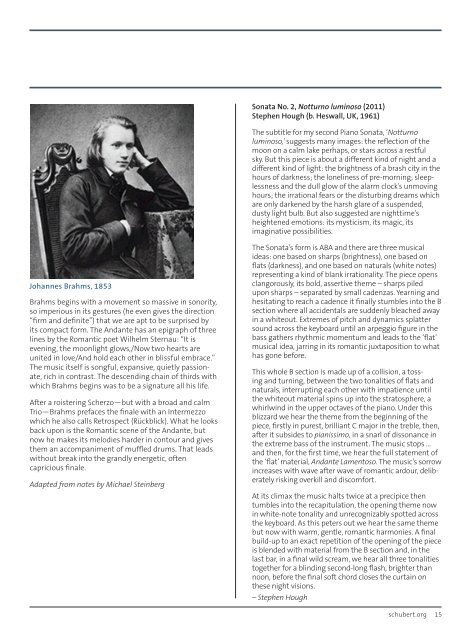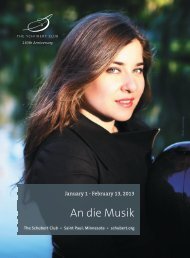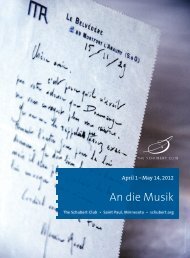schub 2_1112 lowres.pdf - The Schubert Club
schub 2_1112 lowres.pdf - The Schubert Club
schub 2_1112 lowres.pdf - The Schubert Club
Create successful ePaper yourself
Turn your PDF publications into a flip-book with our unique Google optimized e-Paper software.
Johannes Brahms, 1853<br />
Brahms begins with a movement so massive in sonority,<br />
so imperious in its gestures (he even gives the direction<br />
“fi rm and defi nite”) that we are apt to be surprised by<br />
its compact form. <strong>The</strong> Andante has an epigraph of three<br />
lines by the Romantic poet Wilhelm Sternau: “It is<br />
evening, the moonlight glows,/Now two hearts are<br />
united in love/And hold each other in blissful embrace.”<br />
<strong>The</strong> music itself is songful, expansive, quietly passionate,<br />
rich in contrast. <strong>The</strong> descending chain of thirds with<br />
which Brahms begins was to be a signature all his life.<br />
After a roistering Scherzo—but with a broad and calm<br />
Trio—Brahms prefaces the fi nale with an Intermezzo<br />
which he also calls Retrospect (Rückblick). What he looks<br />
back upon is the Romantic scene of the Andante, but<br />
now he makes its melodies harder in contour and gives<br />
them an accompaniment of muffl ed drums. That leads<br />
without break into the grandly energetic, often<br />
capricious fi nale.<br />
Adapted from notes by Michael Steinberg<br />
Sonata No. 2, Notturno luminoso (2011)<br />
Stephen Hough (b. Heswall, UK, 1961)<br />
<strong>The</strong> subtitle for my second Piano Sonata, ‘Notturno<br />
luminoso,’ suggests many images: the refl ection of the<br />
moon on a calm lake perhaps, or stars across a restful<br />
sky. But this piece is about a different kind of night and a<br />
different kind of light: the brightness of a brash city in the<br />
hours of darkness; the loneliness of pre-morning; sleeplessness<br />
and the dull glow of the alarm clock’s unmoving<br />
hours; the irrational fears or the disturbing dreams which<br />
are only darkened by the harsh glare of a suspended,<br />
dusty light bulb. But also suggested are nighttime’s<br />
heightened emotions: its mysticism, its magic, its<br />
imaginative possibilities.<br />
<strong>The</strong> Sonata’s form is ABA and there are three musical<br />
ideas: one based on sharps (brightness), one based on<br />
fl ats (darkness), and one based on naturals (white notes)<br />
representing a kind of blank irrationality. <strong>The</strong> piece opens<br />
clangorously, its bold, assertive theme – sharps piled<br />
upon sharps – separated by small cadenzas. Yearning and<br />
hesitating to reach a cadence it fi nally stumbles into the B<br />
section where all accidentals are suddenly bleached away<br />
in a whiteout. Extremes of pitch and dynamics splatter<br />
sound across the keyboard until an arpeggio fi gure in the<br />
bass gathers rhythmic momentum and leads to the ‘fl at’<br />
musical idea, jarring in its romantic juxtaposition to what<br />
has gone before.<br />
This whole B section is made up of a collision, a tossing<br />
and turning, between the two tonalities of fl ats and<br />
naturals, interrupting each other with impatience until<br />
the whiteout material spins up into the stratosphere, a<br />
whirlwind in the upper octaves of the piano. Under this<br />
blizzard we hear the theme from the beginning of the<br />
piece, fi rstly in purest, brilliant C major in the treble, then,<br />
after it subsides to pianissimo, in a snarl of dissonance in<br />
the extreme bass of the instrument. <strong>The</strong> music stops …<br />
and then, for the fi rst time, we hear the full statement of<br />
the ‘fl at’ material, Andante Lamentoso. <strong>The</strong> music’s sorrow<br />
increases with wave after wave of romantic ardour, deliberately<br />
risking overkill and discomfort.<br />
At its climax the music halts twice at a precipice then<br />
tumbles into the recapitulation, the opening theme now<br />
in white-note tonality and unrecognizably spotted across<br />
the keyboard. As this peters out we hear the same theme<br />
but now with warm, gentle, romantic harmonies. A fi nal<br />
build-up to an exact repetition of the opening of the piece<br />
is blended with material from the B section and, in the<br />
last bar, in a fi nal wild scream, we hear all three tonalities<br />
together for a blinding second-long fl ash, brighter than<br />
noon, before the fi nal soft chord closes the curtain on<br />
these night visions.<br />
– Stephen Hough<br />
<strong>schub</strong>ert.org 15




